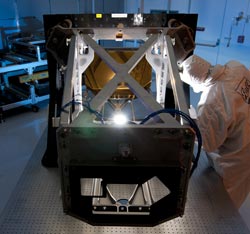NASA'S Webb Telescope Team Completes Optical Milestone

Ball Aerospace Technician Robin Russell inspects the Webb Telescope Aft Optics Subsystem during mirror integration activities. The Aft Optics bench, made of lightweight beryllium like the mirrors, holds Webb's tertiary and fine steering mirrors. The installed, gold-coated tertiary mirror can be seen in the background. Photo courtesy Ball Aerospace. <br>
“Completing Aft Optics System performance testing is significant because it means all of the telescope's mirror systems are ready for integration and testing,” said Lee Feinberg, NASA Optical Telescope Element Manager for the James Webb Space Telescope at the Goddard Space Flight Center in Greenbelt, Md.
Since last May, the AOS has undergone a series of thermal, vibration and cryogenic testing to demonstrate that it can withstand the rigorous vibration environment of the rocket launch and remain precisely aligned in order to function at the extremely cold temperatures in space. The AOS will remain at Ball Aerospace to be used in integrated testing with the flight actuator drive unit and AOS source plate assembly. The AOS is the final optical subsystem in the Webb's Optical Telescope Element to complete integration and test activities at Ball Aerospace.
“Each optical element that Ball Aerospace builds for the Webb is extremely sophisticated,” said David L. Taylor, Ball Aerospace's president and chief executive officer. “The successful completion of another milestone brings us one day closer to the launch of NASA’s next major space observatory.”
The AOS is a precision beryllium rectangular optical bench that houses the tertiary and the fine steering mirror installed at the center of Webb's primary mirror. The AOS is surrounded by a shroud that eliminates stray light, and two large radiator panels that keep the assembly cold. This subsystem collects and focuses the light from the secondary mirror and feeds it into the science instruments.
In September 2012, Ball began the process of shipping the finished Webb primary mirrors to NASA Goddard. The remaining mirrors will arrive at Goddard in 2013, awaiting telescope integration in 2015. The Webb is on track for an October 2018 liftoff.
The James Webb Space Telescope is the world’s next-generation space observatory and successor to the Hubble Space Telescope. The most powerful space telescope ever built, Webb will observe the most distant objects in the universe, provide images of the very first galaxies ever formed and see unexplored planets around distant stars. The Webb Telescope is a joint project of NASA, the European Space Agency and the Canadian Space Agency.
Lynn Chandler
NASA's Goddard Space Flight Center, Greenbelt, Md.
301-286-2806
Lynn.chandler-1@nasa.gov
Media Contact
All latest news from the category: Physics and Astronomy
This area deals with the fundamental laws and building blocks of nature and how they interact, the properties and the behavior of matter, and research into space and time and their structures.
innovations-report provides in-depth reports and articles on subjects such as astrophysics, laser technologies, nuclear, quantum, particle and solid-state physics, nanotechnologies, planetary research and findings (Mars, Venus) and developments related to the Hubble Telescope.
Newest articles

Superradiant atoms could push the boundaries of how precisely time can be measured
Superradiant atoms can help us measure time more precisely than ever. In a new study, researchers from the University of Copenhagen present a new method for measuring the time interval,…

Ion thermoelectric conversion devices for near room temperature
The electrode sheet of the thermoelectric device consists of ionic hydrogel, which is sandwiched between the electrodes to form, and the Prussian blue on the electrode undergoes a redox reaction…

Zap Energy achieves 37-million-degree temperatures in a compact device
New publication reports record electron temperatures for a small-scale, sheared-flow-stabilized Z-pinch fusion device. In the nine decades since humans first produced fusion reactions, only a few fusion technologies have demonstrated…





















